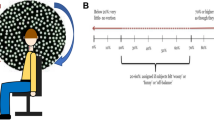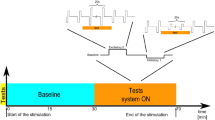Abstract
Dynamic posturography by measurement of center of pressure (COP) is a widely employed technique for evaluating the vestibular system. However, the relationship of COP motion to vestibulo-ocular reflex (VOR) function and image stability on the retina has not been determined previously. To assess these relationships, we report gaze, head, and trunk stability during dynamic posturography in 11 normal volunteers, 7 subjects with unilateral vestibular lesions, and 3 subjects with bilateral vestibular lesions. Posturographic tasks consisted of standing still and standing on a platform that was sliding (0.2 Hz), tilting (0.1 Hz), or covered with a foam cushion 6 cm thick while tilting (0.1 Hz). Each perturbation was imposed in the anterior-posterior and repeated in the medial-lateral direction, in both light and darkness. Subjects viewed (or in darkness remembered) a target located 50, 100, or 500 cm distant. COP, angular eye position, and angular and linear orbit and trunk positions were measured using magnetic search coils and flux gate magnetometer sensors. With the target visible, the velocity of image motion on the retina was on average always less than 1°/s, well within the range consistent with high visual acuity. In darkness, gaze velocity increased for normal and vestibulopathic subjects. During tilt, vestibulopathic subjects had a significantly greater gaze velocity than controls. Gain of the angular VOR (eye velocity/head velocity) was significantly lower in darkness than in light and in vestibulopathic as compared to control subjects. Gain of the VOR was significantly correlated with gaze instability, but variation in VOR gain accounted for only 20–40% of the variance. In darkness, the velocity of the COP was significantly greater in vestibulopathic than control subjects for every condition tested. In light, this difference was small and often not significant. Although spectral analysis of the COP indicated frequencies above 1 Hz that were not observed in motion of the trunk and orbit, root mean square (RMS) velocities of the trunk and orbit in the horizontal plane were higher in darkness and in vestibulopathic subjects, mirroring COP findings. Only in vestibulopathic subjects tested in darkness was there a correlation between COP velocity and gaze velocity; COP velocity was otherwise uncorrelated with gaze. Gaze velocity was greater with near than with distant targets. Vertical VOR gain was higher with near targets. No other significant effects of target distance were found. Head movement strategy, VOR gain, and COP were all unaffected by target proximity. These data show that gaze velocity measurements during dynamic posturography in darkness are sensitive to vestibular loss. With a visible target, both COP and gaze stability of vestibulopathic subjects are difficult to distinguish from normal. During visual feedback, it is likely that image stabilization over the range of frequencies tested is achieved through better head stability and through visual tracking, allowing vestibulopathic subjects to maintain adequate visual acuity.
Similar content being viewed by others
Author information
Authors and Affiliations
Additional information
Received: 25 November 1997 / Accepted: 24 April 1998
Rights and permissions
About this article
Cite this article
Crane, B., Demer, J. Gaze stabilization during dynamic posturography in normal and vestibulopathic humans. Exp Brain Res 122, 235–246 (1998). https://doi.org/10.1007/s002210050511
Issue Date:
DOI: https://doi.org/10.1007/s002210050511




